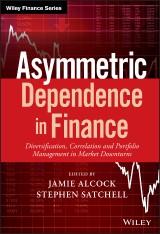Details

Asymmetric Dependence in Finance
Diversification, Correlation and Portfolio Management in Market DownturnsWiley Finance 1. Aufl.
|
81,99 € |
|
| Verlag: | Wiley |
| Format: | EPUB |
| Veröffentl.: | 13.02.2018 |
| ISBN/EAN: | 9781119289029 |
| Sprache: | englisch |
| Anzahl Seiten: | 312 |
DRM-geschütztes eBook, Sie benötigen z.B. Adobe Digital Editions und eine Adobe ID zum Lesen.
Beschreibungen
<b>Avoid downturn vulnerability by managing correlation dependency</b> <p><i>Asymmetric Dependence in Finance</i> examines the risks and benefits of asset correlation, and provides effective strategies for more profitable portfolio management. Beginning with a thorough explanation of the extent and nature of asymmetric dependence in the financial markets, this book delves into the practical measures fund managers and investors can implement to boost fund performance. From managing asymmetric dependence using Copulas, to mitigating asymmetric dependence risk in real estate, credit and CTA markets, the discussion presents a coherent survey of the state-of-the-art tools available for measuring and managing this difficult but critical issue. <p>Many funds suffered significant losses during recent downturns, despite having a seemingly well-diversified portfolio. Empirical evidence shows that the relation between assets is much richer than previously thought, and correlation between returns is dependent on the state of the market; this book explains this asymmetric dependence and provides authoritative guidance on mitigating the risks. <ul> <li>Examine an options-based approach to limiting your portfolio's downside risk</li> <li>Manage asymmetric dependence in larger portfolios and alternate asset classes</li> <li>Get up to speed on alternative portfolio performance management methods</li> <li>Improve fund performance by applying appropriate models and quantitative techniques</li> </ul> <p>Correlations between assets increase markedly during market downturns, leading to diversification failure at the very moment it is needed most. The 2008 Global Financial Crisis and the 2006 hedge-fund crisis provide vivid examples, and many investors still bear the scars of heavy losses from their well-managed, well-diversified portfolios. <i>Asymmetric Dependence in Finance</i> shows you what went wrong, and how it can be corrected and managed before the next big threat using the latest methods and models from leading research in quantitative finance.
<p>About the Editors ix</p> <p>Introduction xi</p> <p>CHAPTER 1 Disappointment Aversion, Asset Pricing and Measuring Asymmetric Dependence 1<br /><i>Jamie Alcock and Anthony Hatherley</i></p> <p>CHAPTER 2 The Size of the CTA Market and the Role of Asymmetric Dependence 17<br /><i>Stephen Satchell and Oliver Williams</i></p> <p>CHAPTER 3 The Price of Asymmetric Dependence 47<br /><i>Jamie Alcock and Anthony Hatherley</i></p> <p>CHAPTER 4 Misspecification in an Asymmetrically Dependent World: Implications for Volatility Forecasting 75<br /><i>Salman Ahmed, Nandini Srivastava and Stephen Satchell</i></p> <p>CHAPTER 5 Hedging Asymmetric Dependence 110<br /><i>Anthony Hatherley</i></p> <p>CHAPTER 6 Orthant Probability-Based Correlation 133<br /><i>Mark Lundin and Stephen Satchell</i></p> <p>CHAPTER 7 Risk Measures Based on Multivariate Skew Normal and Skew t -Mixture Models 152<br /><i>Sharon X. Lee and Geoffrey J. McLachlan</i></p> <p>CHAPTER 8 Estimating Asymmetric Dynamic Distributions in High Dimensions 169<br /><i>Stanislav Anatolyev, Renat Khabibullin and Artem Prokhorov</i></p> <p>CHAPTER 9 Asymmetric Dependence, Persistence and Firm-Level Stock Return Predictability 198<br /><i>Jamie Alcock and Petra Andrlikova</i></p> <p>CHAPTER 10 The Most Entropic Canonical Copula with an Application to ‘Style’ Investment 221<br /><i>Ba Chu and Stephen Satchell</i></p> <p>CHAPTER 11 Canonical Vine Copulas in the Context of Modern Portfolio Management: Are They Worth It? 263<br /><i>Rand Kwong Yew Low, Jamie Alcock, Robert Faff and Timothy Brailsford</i></p> <p>Index 291</p>
<p><b>JAMIE ALCOCK, P<small>H</small>D,</b> is Associate Professor of Finance at the University of Sydney Business School. He has previously held appointments at the University of Cambridge, Downing College Cambridge, and the University of Queensland. Dr. Alcock's research interests include asset pricing, corporate finance, and real estate finance. The quality of his research has been recognized through multiple international research prizes, including most recently the EPRA Best Paper prize at the 2016 European Real Estate Society conference. <p><b>STEPHEN SATCHELL, P<small>H</small>D, P<small>H</small>D,</b> is a Life Fellow at Trinity College Cambridge, a Professor of Finance at the University of Sydney and was an Honorary Visiting Professor at Birkbeck College, University of London. He is the Emeritus Reader in Financial Econometrics at the University of Cambridge and is an Honorary Member of the Institute of Actuaries. He specializes in finance and econometrics, on which he has written at least 200 papers.
<p><b>The Guide to Avoiding Downturn Vulnerability by Managing Correlation Dependency</b> <p>Solidly grounded in quantitative finance research, <i>Asymmetric Dependence in Finance</i> is the definitive resource that offers an important analysis of the risks and benefits of asset correlation. The book spans the topics — managing asymmetric dependence using Copulas, to mitigating asymmetric dependence risk in real estate, credit and CTA markets — that comprise a survey of the most current tools available for measuring and managing this crucial issue. <p>With contributions from noted experts in the field, this book explores the risks and benefits of asset correlation and offers the most current strategies and models that can be implemented to protect investments that are no longer insulated from downturns by simply diversifying funds. It clearly shows that the relation between assets is much richer than previously thought, and correlation between returns is dependent on the state of the market. Correlations between assets significantly increase during market downturns compared to market upturns. The benefits of diversification collapse at the very time fund managers need to rely on diversification. <p>To help investors avoid financial disasters such as the 2008 global financial crisis and the 2006 hedge-fund crisis, the authors outline practical measures that can be implemented to boost fund performance and a proven strategy for putting in place an options-based approach that limits a portfolio's risk. <p>Written for fund managers, investors and financial officers, <i>Asymmetric Dependence in Finance</i> presents the most effective tools and strategies for improving fund, portfolio, and organization performance.
Diese Produkte könnten Sie auch interessieren:

Counterparty Credit Risk, Collateral and Funding

von: Damiano Brigo, Massimo Morini, Andrea Pallavicini

69,99 €
















